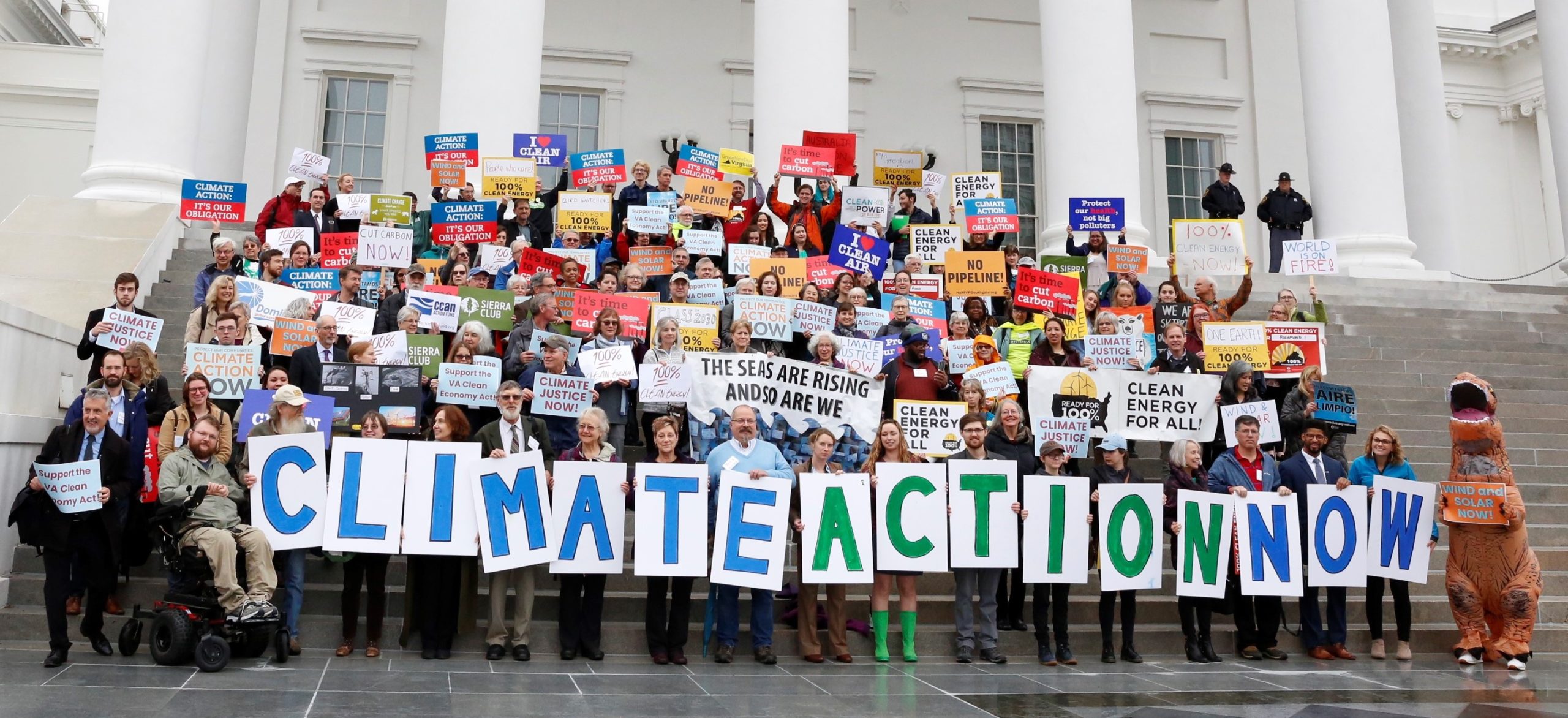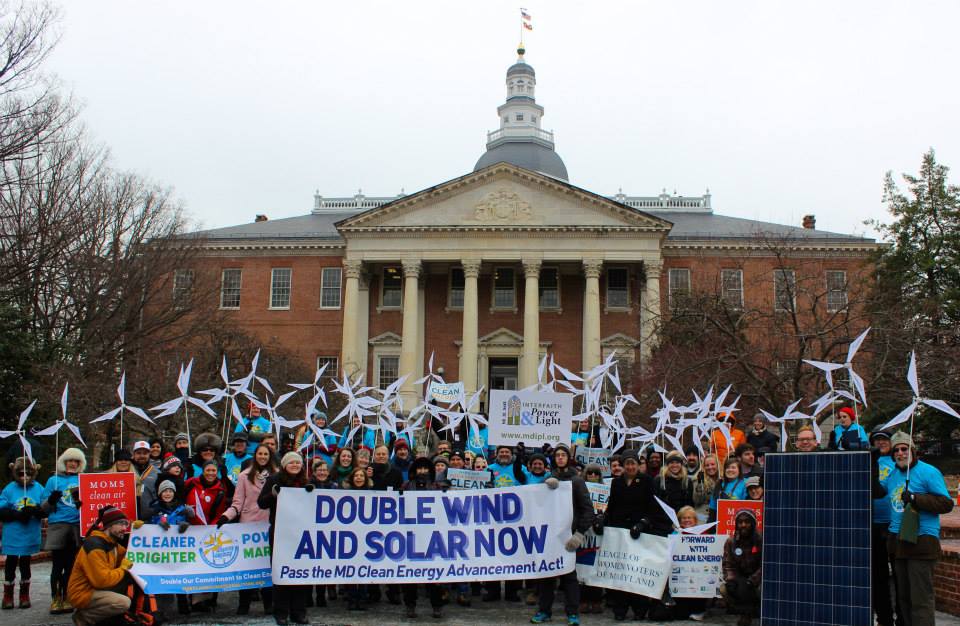House and Senate Pass “Virginia Clean Economy Act” on Tuesday, Feb 11
By Mike Tidwell
When it comes to clean energy policy, environmental activists nationwide commonly think of the Chesapeake Climate Action Network as true “climate hawks.” We sue polluters. We picket against companies like Dominion Energy. And when the time is right, our lobbying arm CCAN Action Fund, pushes HARD for transformative clean energy laws. Our collective actions over the past 18 years have led Bill McKibben of 350.org to call CCAN “the best regional grassroots climate group in the world.”
So when I tell you we strongly support the Virginia Clean Economy Act, it’s for one reason: It’s a strong and transformative bill. This legislation, which passed in both the House of Delegates and the Senate on Tuesday, February 11th, will now cross over to be heard in the opposite chamber. The goal is to get it to the Governor’s desk as soon as possible, where he says he wants to sign it.
CUTTING TO THE CHASE: This bill shuts down Dominion’s coal-fired power plants in a HURRY. It brings a tidal wave of wind and solar power to Virginia. And it protects low-income ratepayers with ironclad provisions.
Both House and Senate versions of the VCEA would effectively shut down ALL of Dominion’s coal plants by 2030. All of Virginia’s utility-owned gas plants – all of them – would shut down by 2045, but probably much sooner under this legislation. At the same time, the House and Senate bills will midwife the largest offshore wind farms in the nation and turbo charge the spread of both distributed rooftop solar power and properly sited solar farms. Both bills invest half a BILLION dollars in energy efficiency gains for low-income households over the next decade. And they cap the electric bills of low-income families at a guaranteed sustainable level, a game-changing move. Finally, despite the understandable suspicion (given history) that Dominion would only agree to a bill that gouges ratepayers, these bills contain bill-lowering competition for solar and wind projects that will keep prices down. The House bill, meanwhile, has even stronger mandates for energy efficiency gains to protect consumers.
WHO SUPPORTS THE BILL?
Before digging into the bill in greater depth, keep in mind that the Virginia Clean Economy Act is supported by the biggest clean energy coalition ever assembled not just in Virginia but perhaps in the nation. I say this from experience working across the mid-Atlantic and in much of the rest of the country. It is a sign of the times and a sign of the extraordinary work done in Virginia that virtually every major environmental group in the state, all the wind and solar companies operating in the state, and yes the main electricity polluters – Dominion and Appalachian Power Company – support either the Senate version of the bill or the House version. (Both bills make strong progress and will have a hearing in the opposite chamber soon). The supporters are too many to name here but they include Sierra Club, Virginia Interfaith Power and Light, CCAN Action Fund, Southern Environmental Law Center, Sigora Solar, Orsted wind, and many progressively run corporations in the state like the Mars candy company and Akamai Technologies. This type of coalition is unprecedented in a southern coal state, for sure, but virtually unheard of anywhere in the country. Again, for critics who suspect Dominion is just gaming the system with another anti-consumer bad energy bill, you would have to believe that all of the groups – including mine – have been deceived after weeks of negotiations and careful bill writing. The truth: these groups support the bill because the net positive effect is tremendous for Virginia.

250 people came to Richmond to lobby for the VCEA in January.
A DEEPER DIVE INTO WHAT THE VCEA DOES:
Creates New Ratepayer Protections to Keep Bills Low
The Virginia Clean Economy Act would provide half a billion dollars in home weatherization funds for low-income households. It requires half of the funds from the Regional Greenhouse Gas Initiative to help low-income residents invest in efficiency to keep bills low. The other half will go towards flooding assistance, with about $250 million earmarked for low-income communities.
The VCEA also creates Virginia’s first binding energy efficiency savings targets. Now, Dominion Energy will have to prove that their customers are using 5% less energy over a 2019 baseline by 2025. The savings target for ApCo is 2% of current load by 2025.
It also includes additional provisions to keep bills low for clean energy projects. On offshore wind, the bill requires Dominion to hold a competitive bidding process to find the company that will build the turbines for the best price. There’s also a cost ceiling to keep the cost of electricity low.
On solar, the bill will allow for up to 35% of the solar required in this bill to be owned by third party companies (i.e., not Dominion). This will allow for more competitive pricing on electricity from solar power. It also would utilize the “Percentage of Income Payment Plan” (PIPP) to cap energy bills for low-income ratepayers at a guaranteed affordable level.
Creates a Renewable Portfolio Standard
A Renewable Portfolio Standard (RPS) is a state law that requires utilities to deliver a specified amount of renewable energy such as wind and solar to their customers. The VCEA requires 100% clean electricity by 2045 for Dominion Energy and 2050 for Appalachian Power Company (ApCo), with a benchmark of 30% renewable by 2030. Renewable energy is defined as electricity from wind, solar, falling water, and other in-state resources. For Dominion, 75% of all renewable energy must come from the Commonwealth in 2025 and beyond.
This bill creates the only mandatory RPS with a target of 100% clean energy in the South and one of the stronger versions of the law of any state in the country, putting the state within shouting distance of leading states like Maryland.
Expands Wind and Solar Energy

The VCEA would launch the largest offshore wind farms in America while turbo-charging the state’s solar industry. It establishes offshore wind as a substantial portion of the RPS as offshore wind comes online, and deploys 5,200MW by 2034, making Virginia a leader in offshore wind. It also includes labor provisions to require the use of local labor.
For distributed solar, it establishes rooftop solar as a portion of the RPS up to 1% annually beginning in 2021. It increases the cap on power purchase agreements to 500MW in Dominion territory and 40MW in ApCo service territories. It expands net metering by increasing the net metering cap to 6%, including 1% specifically set aside for low-to-moderate income communities, and allows larger projects to net meter. It also requires utilities to develop more than 16,000MW of renewable energy by 2035, equivalent to enough electricity for 3 million homes.
Key to the success of offshore wind and solar power is energy storage. The VCEA sets targets for energy storage of 3,100MW by 2035, including 2,700MW for Dominion and 400MW for ApCo. It also requires 10% of energy storage projects to be deployed directly “behind the meter” for power backups at hospitals, government facilities, and more.
Ends Fossil Fuel Emissions

The Virginia Clean Economy Act would shut down virtually all of Dominion’s coal-fired power plants by 2030, all biomass facilities by December 31, 2028 and the rest of the state’s fossil fuel power plants by 2045. This makes us the only state in the South with a mandate to shut down all fossil fuels.
While this House Bill does not create an outright moratorium on new fossil fuel development, it serves as a de facto moratorium on carbon-intensive electricity in Virginia by mandating a carbon-free grid by 2045 with exceptional interim goals by 2030. It also requires the Secretaries of Natural Resources and Commerce & Trade to report recommendations on how to achieve 100% carbon free electricity and fossil-fuel retirements. It bars the State Corporation Commission (SCC) from issuing new permits for power plants powered by fossil fuels until that study is received by the General Assembly.
Finally, it deters any utility spending on projects that do not help lower energy usage. Dominion will have to prove that they are meeting energy efficiency targets to lower overall energy usage before they are allowed to construct any new power plants powered by fossil fuels.
Advance Environmental Justice
Justice is incorporated into every aspect of the VCEA.
The ratepayer protection provisions were laid out above. Further, the bill requires the Virginia Department of Mines, Minerals and Energy and the Environmental Justice council to prepare a report to ensure VCEA doesn’t disproportionately burden minority and historically-disadvantaged communities. It includes language to ensure reliability is protected. And it sets the policy of the Commonwealth to consider low-income areas & historically disadvantaged communities when considering new renewable projects, energy programs, and job training. Finally, it requires utilities to consult with the Clean Energy Advisory Board on how best to inform low-income customers about their solar options.
Summary:
This bill is not the end for the climate fight. We will have to come back for transportation, agriculture, and more, until every sector of the economy is in line with the science. But the facts speak for themselves: This bill will hold Dominion dramatically accountable on rates and fossil fuels emissions. This is the best first step on climate a state has ever taken.

Happy CCAN Virginia team after the bill passed the House.







